Sunday, 12 June 2011: Bourg-en-Bresse to Anse, via the Dombes
Written 25 June 2011
The next restaurant David had chosen for us was the Salle des Gardes (The Guardroom) in a hotel called Le Château de Bagnols, in the tiny town of Bagnols, up in the hills west of the Saône. The hotel was way out of our price range, and for once, not even a thorough search of the web turned up any other lodging nearby, so we reserved a room for two nights at the Saint-Romain, a hotel in Anse, down on the river. (An "anse" is any curved handle, like that on a teapot, teacup, or pitcher, and the word is also applied to any river bend of a similar shape. The town of Anse is on such a bend.) The hotel's restaurant was itself listed in the Gault-Millau but not as highly rated as the Salle des Gardes.
Our route from Bourg to Anse lay through an area (once an independent principality) called Les Dombes, an area so heavily freckled with ponds that, on the map, it looks to be about 50% water. On the ground, as you drive through, it doesn't seem quite that wet, though I understand that some of the ponds are seasonal; we may not have been there at the right time. Wikipedia will tell you all about the geological conditions that contribute to its pondfulness. At least since the 15th century, it has been an area of fish farming, and apparently pike, carp, and tench are still farmed there. That's where they get the pike for all those quenelles. I had hoped to see carp on menus, but it never turned up. I have no idea what they do with the tench. Needless to say, frogs historically abounded there, so a common menu item is frogs "cooked as in Les Dombes" (i.e., crumbed and sautéed and served with butter, parsley, garlic, and lemon).
I had been interested in seeing the area, and in addition, my college classmate Mary O'Keefe Kellogg, who lives with her husband in Prévessin-Moëns, France, near Geneva, had recommended a restaurant called "Le Thou" ("the floodgate," like the ones used to move water around in irrigation ditches; that's a drawing of one on its blue garage door) in the Dombes, in a tiny village named Bouligneux. We therefore drove a meandering, scenic route through the area, calculated to get us to Bouligneux about lunch time. The land that wasn't under water was under cultivation, planted with the usual stuff—grain (mostly wheat), corn (i.e., maize), sunflowers (for oil; not yet in bloom), and colza (oil-seed rape, covered with siliques and drying for harvest). We saw only a few fields of potatoes on this trip and no broad beans at all.
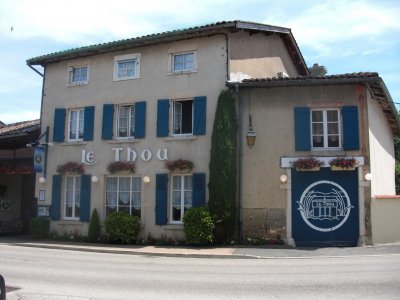
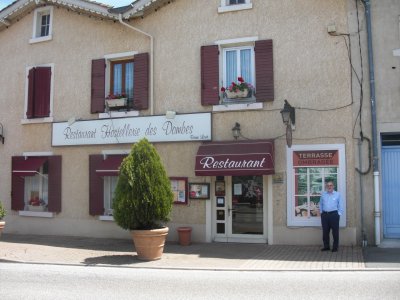 I didn't reserve at Le Thou because, when we set out I couldn't be sure the timing would work, but as it happens, we pulled up in front of it exactly at noon, only to be told that the last table had just been taken. It was Sunday, and apparently Le Thou is a popular after-church venue for family dinners. Fortunately, Bouligneux's modern claim to fame is its restaurants, three of them, cheek-by-jowl in the one-block downtown, so we went next door to the "Hostellerie des Dombes," where they had to check to make sure they had space for us. Later, when we walked past the nearby "Auberge des Chasseurs," we could see that it, too, had filled every table.
I didn't reserve at Le Thou because, when we set out I couldn't be sure the timing would work, but as it happens, we pulled up in front of it exactly at noon, only to be told that the last table had just been taken. It was Sunday, and apparently Le Thou is a popular after-church venue for family dinners. Fortunately, Bouligneux's modern claim to fame is its restaurants, three of them, cheek-by-jowl in the one-block downtown, so we went next door to the "Hostellerie des Dombes," where they had to check to make sure they had space for us. Later, when we walked past the nearby "Auberge des Chasseurs," we could see that it, too, had filled every table.
At the hostellerie, we were seated at the bottom of the terrace behind the restaurant, just one table from the open meadow behind it. Once again, we were constrained by the knowledge that we had reservations at a very highly rated restaurant that evening, so we ordered just one course each. Of course they brought us an amuse-bouche, too, consisting of, for each of us, a puff-pastry fleuron with cheese, one with anhovy, and a (fortunately appetizer-sized) slice of sausage in brioche. And of course, evening reservations or no, we ate them.
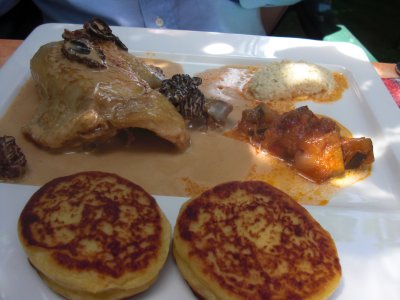
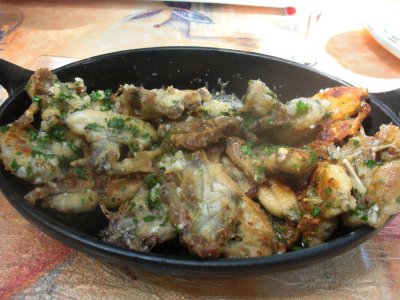 Main course, David: Breast of Bresse chicken with morel cream sauce.
Main course, David: Breast of Bresse chicken with morel cream sauce.
Main course, me: Frogs. I was tempted by the halibut with sorrel sauce, but in the Dombes, you just have to eat frogs. Both were listed under "fish" on the menu.
Both dishes were accompanied by a spoonful of a ratatouille-like mixture of vegetables and a spoonful of something finely diced in a cream sauce—fennel, we think. And bread, of course. The best accompaniment, though, was the pair of crispy, creamy potato cakes (made with mashed potato). I'll have to try those at home.
This was where I asked our server whether the frogs were local and whether they were wild-caught or farmed. They were wild-caught—no one has succeeded in farming frogs, she said; they insist on migrating right after metamorphosis—but were not from France. As I've always said, nothing drives a species toward extinction faster than a really good recipe. The frogs in France (or at least in the Dombes) are now protected. The ones in the restaurants are shipped in live from eastern Europe and, unlike snails, which restaurants purchase already cooked, are prepared from that state in the restaurant's kitchen.
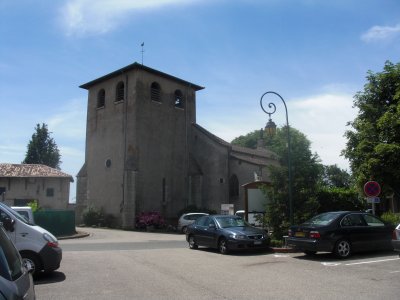
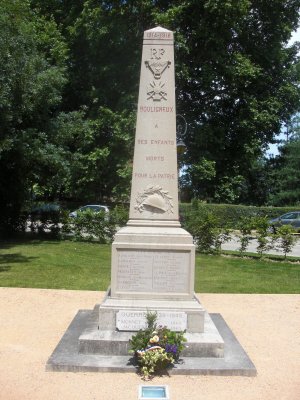 After lunch, we took a turn around the village. Aside from the three restaurants, we came across only l'Église Saint-Marcel de Bouligneux, the tiny village church, which has 13th- and 14th-century frescos badly in need of restoration—a sign out front invites contributations to the fund—and the war memorial. It was typical of many in France in that it listed 14 names of locals killed in WWI (from a population that can barely have numbered in the hundreds) and the two names from WWII had been added below, on a separate, lighter-colored plaque, almost as an afterthought. Note the lighting fixture set in the ground at the bottom, below the fresh flowers. The memorial is lighted at night.
After lunch, we took a turn around the village. Aside from the three restaurants, we came across only l'Église Saint-Marcel de Bouligneux, the tiny village church, which has 13th- and 14th-century frescos badly in need of restoration—a sign out front invites contributations to the fund—and the war memorial. It was typical of many in France in that it listed 14 names of locals killed in WWI (from a population that can barely have numbered in the hundreds) and the two names from WWII had been added below, on a separate, lighter-colored plaque, almost as an afterthought. Note the lighting fixture set in the ground at the bottom, below the fresh flowers. The memorial is lighted at night.
From Bouligneux, we drove pretty directly to Anse. We already knew where our hotel was, as we had driven right by it on our way from Lyon to Mâcon a few days earlier. After settling into the room, we walked downtown (part of the way through a lovely park with a large rose garden) on the off chance that the tourist office would be open on a Sunday. It wasn't, and it bore a hand-lettered sign to the effect that it would be "exceptionellement" closed on Monday, too. Drat. I knew of only one tourist attraction in Anse—a miniature railway (1.5 km of 15-inch-gauge track)—and I had already confirmed on the internet (the hotel had free WiFi) that in June it runs only on Saturdays and Sundays and that we had already missed its last run of the day. Anse isn't even in the Michelin guide.
So we strolled across the street to read a historical marker we could see there, and that led us to the local Château des Deux Tours (the castle of the two towers). One tower is round; the other is semicircular. The two are connected by a rectangular section, and the whole thing is now an art gallery, which was open! So we visited an exhibition of water-colors and clay modeling by local art students, both children and adults, plus a little work by their instructors. Many interesting comparisons, as each class had apparently been given a picture to copy (I recognized some—posted next to the copies—as postcards), so we got to see many different students' takes on copying the same model. One section was even entitled "from the figurative to the abstract," and the assignment was apparently to portray the transition. Many students did so quite successfully—I was impressed.
The Salle des Gardes was the only restaurant on the trip to and from which we had to drive, and because I always get to drive home (so that David can drink wine with dinner) I usually drive to the restaurant as well, to get a little experience with the route. This one turned out to be easy—it was steep and twisty and involved a great many hairpin turns, but it was necessarily low-speed, and all the turns were well marked. Piece of cake. It even involved two stop signs, a rarity in France, especially in the country. And it was out in the country. The views were spectacular, both by day and after dark, when all the villages were lit up, as we climbed up out of the river valley, over a ridge and down into a valley, then up the other side again to the restaurant.
We drove up to the castle's imposing iron gates, but nothing happened. No one was around, and you apparently needed to punch in a code to open the gates, so we parked in the handy town square and addressed ourselves to a small wooden postern gate in the 10-foot stone wall. Locked. So we pressed the button on the intercom, were briefly interrogated by someone inside, and were buzzed in.
Beyond the door, we found ourselves in an old carriage shed (with old carriage) where big bundles of lavender were hanging from the rafters to dry. We proceeded through it into a large tree-shaded courtyard, where we were met by someone from the restaurant, coming out to escort us in. From the grassy, tree-shaded courtyard we turned right, across a small wooden drawbridge, into an inner, stone courtyard, where we could see straight through a wall of glass into the kitchens! Then left and into the actual guardroom, where the restaurant was set up. It featured a large (a very large) fireplace—I could easily have stood up in it, with a couple of feet to spare, and it was at least twice as wide as it was tal (I've read somwhere that it might be the largest in France)l—surmounted by a flamboyant Gothic archway and housing, throughout dinner, a blazing fire of real logs. The tables were set with beautiful old heavy silver, including, on each table, a two-sided boat-shaped salt-cellar. The silver cover on one side covered coarse salt; that on the other fine salt.
We settled on the menu "Guichard d'Oingt" (builder of the castle);—"Oingt" is a nearby town—which involved no choices, so we both ate the same thing.
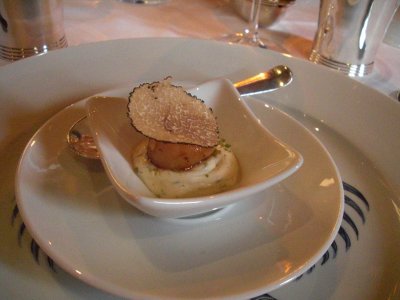
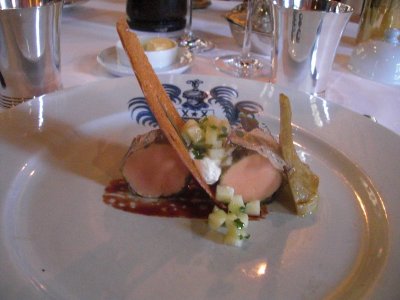 Amuse-bouche: Cervelle de canut (mascarpone flavored with herbs and shallots), topped with scallop marinated in sherry vinaigrette, in turn topped with a thin slice of fresh summer truffle.
Amuse-bouche: Cervelle de canut (mascarpone flavored with herbs and shallots), topped with scallop marinated in sherry vinaigrette, in turn topped with a thin slice of fresh summer truffle.
First course: Foie gras rolled up in thin sheets of cooked eggplant and served with half an artichoke bottom, a vinaigrette made with walnut oil, a thin slice of crispy toast, a dab of mascarpone, and some diced apple. Sorry about the black logo painted on all the plates—it does not, in my opinion, enhance the photos.
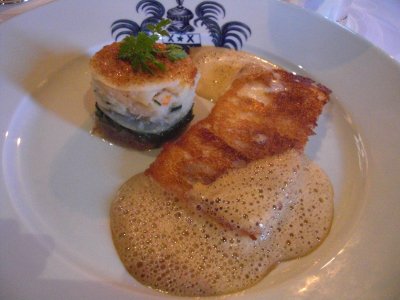
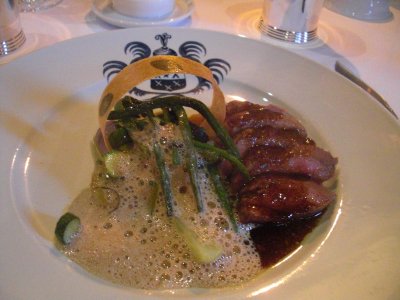 Second course: "Omble chevalier" (arctic char, Salvelinus alpinus alpinus, a salmonid fish similar to trout), crispy and melting, with a "lasagne of celery and confit shallots" and an "iodized" meat juice. I liked it alot, David less so. The square slices of fish had been thinly coated with something (mashed potato, we think) that formed a lovely crispy surface, and the fish itself was moist and tender. The "lasagne" consisted of layers of spinach, thin slices of celery root, confit shallots, and a bunch of other stuff. Tasty, but all the layers tended slide in different directions when you tried to cut off a bite.
Second course: "Omble chevalier" (arctic char, Salvelinus alpinus alpinus, a salmonid fish similar to trout), crispy and melting, with a "lasagne of celery and confit shallots" and an "iodized" meat juice. I liked it alot, David less so. The square slices of fish had been thinly coated with something (mashed potato, we think) that formed a lovely crispy surface, and the fish itself was moist and tender. The "lasagne" consisted of layers of spinach, thin slices of celery root, confit shallots, and a bunch of other stuff. Tasty, but all the layers tended slide in different directions when you tried to cut off a bite.
Third course: Roasted veal tenderloin with a juice flavored with anchovies and olive oil and a fricasee of tiny young vegetables. The veal was great, but the vegetables were outstanding! Tiny little zucchini slices, baby green beans, peas, baby broad beans, olives, tiny turnips, artichoke hearts, baby fennel—all wonderful. The circular object is two layers of feuille de brik with small herb leaves sandwiched between them, then cut into strips, wound around something large and cylindrical and baked until crispy. Fun and tasty.
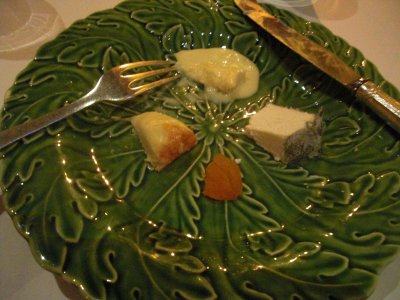
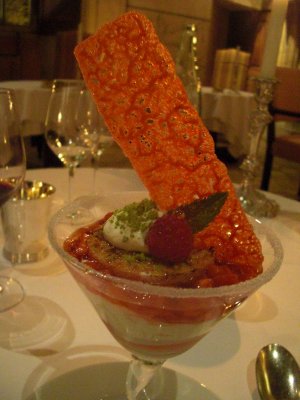 Cheese: Here's my plate (already half eaten, I'm afraid), with lovely runny Saint Marcellin, Époisse, and Valençay (the ashed one).
Cheese: Here's my plate (already half eaten, I'm afraid), with lovely runny Saint Marcellin, Époisse, and Valençay (the ashed one).
Dessert: A short of parfait of strawberries and raspberries with mascarpone, a thin strawberry-flavored cookie, a disk of shortbread cookie, and a shower of minced pistachios.
Mignardises: Tangy little mint-lime sodas. Strips of delicious sesame-poppy-seed cookie were laid across the tops, and the white objects—pear sorbet with bits of fruit in them—were balanced on those.
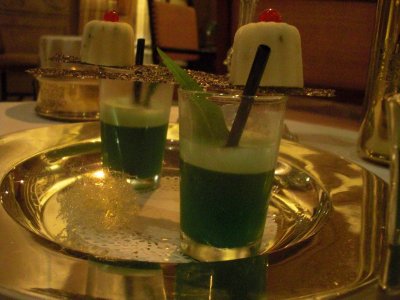
previous entry
List of Entries
next entry

 I didn't reserve at Le Thou because, when we set out I couldn't be sure the timing would work, but as it happens, we pulled up in front of it exactly at noon, only to be told that the last table had just been taken. It was Sunday, and apparently Le Thou is a popular after-church venue for family dinners. Fortunately, Bouligneux's modern claim to fame is its restaurants, three of them, cheek-by-jowl in the one-block downtown, so we went next door to the "Hostellerie des Dombes," where they had to check to make sure they had space for us. Later, when we walked past the nearby "Auberge des Chasseurs," we could see that it, too, had filled every table.
I didn't reserve at Le Thou because, when we set out I couldn't be sure the timing would work, but as it happens, we pulled up in front of it exactly at noon, only to be told that the last table had just been taken. It was Sunday, and apparently Le Thou is a popular after-church venue for family dinners. Fortunately, Bouligneux's modern claim to fame is its restaurants, three of them, cheek-by-jowl in the one-block downtown, so we went next door to the "Hostellerie des Dombes," where they had to check to make sure they had space for us. Later, when we walked past the nearby "Auberge des Chasseurs," we could see that it, too, had filled every table.
 Main course, David: Breast of Bresse chicken with morel cream sauce.
Main course, David: Breast of Bresse chicken with morel cream sauce.
 After lunch, we took a turn around the village. Aside from the three restaurants, we came across only l'Église Saint-Marcel de Bouligneux, the tiny village church, which has 13th- and 14th-century frescos badly in need of restoration—a sign out front invites contributations to the fund—and the war memorial. It was typical of many in France in that it listed 14 names of locals killed in WWI (from a population that can barely have numbered in the hundreds) and the two names from WWII had been added below, on a separate, lighter-colored plaque, almost as an afterthought. Note the lighting fixture set in the ground at the bottom, below the fresh flowers. The memorial is lighted at night.
After lunch, we took a turn around the village. Aside from the three restaurants, we came across only l'Église Saint-Marcel de Bouligneux, the tiny village church, which has 13th- and 14th-century frescos badly in need of restoration—a sign out front invites contributations to the fund—and the war memorial. It was typical of many in France in that it listed 14 names of locals killed in WWI (from a population that can barely have numbered in the hundreds) and the two names from WWII had been added below, on a separate, lighter-colored plaque, almost as an afterthought. Note the lighting fixture set in the ground at the bottom, below the fresh flowers. The memorial is lighted at night.
 Amuse-bouche: Cervelle de canut (mascarpone flavored with herbs and shallots), topped with scallop marinated in sherry vinaigrette, in turn topped with a thin slice of fresh summer truffle.
Amuse-bouche: Cervelle de canut (mascarpone flavored with herbs and shallots), topped with scallop marinated in sherry vinaigrette, in turn topped with a thin slice of fresh summer truffle.
 Second course: "Omble chevalier" (arctic char, Salvelinus alpinus alpinus, a salmonid fish similar to trout), crispy and melting, with a "lasagne of celery and confit shallots" and an "iodized" meat juice. I liked it alot, David less so. The square slices of fish had been thinly coated with something (mashed potato, we think) that formed a lovely crispy surface, and the fish itself was moist and tender. The "lasagne" consisted of layers of spinach, thin slices of celery root, confit shallots, and a bunch of other stuff. Tasty, but all the layers tended slide in different directions when you tried to cut off a bite.
Second course: "Omble chevalier" (arctic char, Salvelinus alpinus alpinus, a salmonid fish similar to trout), crispy and melting, with a "lasagne of celery and confit shallots" and an "iodized" meat juice. I liked it alot, David less so. The square slices of fish had been thinly coated with something (mashed potato, we think) that formed a lovely crispy surface, and the fish itself was moist and tender. The "lasagne" consisted of layers of spinach, thin slices of celery root, confit shallots, and a bunch of other stuff. Tasty, but all the layers tended slide in different directions when you tried to cut off a bite.
 Cheese: Here's my plate (already half eaten, I'm afraid), with lovely runny Saint Marcellin, Époisse, and Valençay (the ashed one).
Cheese: Here's my plate (already half eaten, I'm afraid), with lovely runny Saint Marcellin, Époisse, and Valençay (the ashed one).